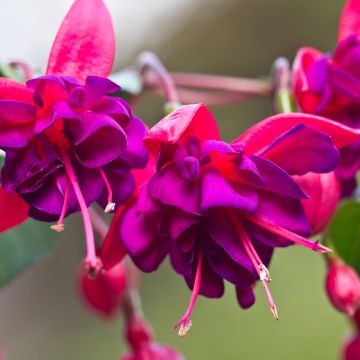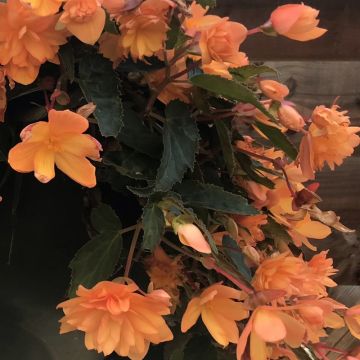

Fuchsia Bush Paula Jane
Fuchsia Paula Jane
Fuchsia x hybrida Paula Jane
Trailing Fuchsia
Special offer!
Receive a €20 voucher for any order over €90 (excluding delivery costs, credit notes, and plastic-free options)!
1- Add your favorite plants to your cart.
2- Once you have reached €90, confirm your order (you can even choose the delivery date!).
3- As soon as your order is shipped, you will receive an email containing your voucher code, valid for 3 months (90 days).
Your voucher is unique and can only be used once, for any order with a minimum value of €20, excluding delivery costs.
Can be combined with other current offers, non-divisible and non-refundable.
Home or relay delivery (depending on size and destination)
Schedule delivery date,
and select date in basket
This plant carries a 6 months recovery warranty
More information
We guarantee the quality of our plants for a full growing cycle, and will replace at our expense any plant that fails to recover under normal climatic and planting conditions.
Would this plant suit my garden?
Set up your Plantfit profile →
Description
The Fuchsia 'Paula Jane' forms a small bushy and dense habit adorned with dark green leaves. It is adorned with adorable semi-double, round and chubby flowers in a delightful palette of pink to almost red tones: on each one, a tube and outer sepals ranging from white to candy pink reveal a corolla of beetroot color, turning to ruby as the flower blooms. This wonderful variety, not very hardy, is easy to grow as an annual in a semi-shaded flower bed. Grown in a large pot, it will enliven the terrace or balcony for long weeks.
Hybrid Fuchsias are countless, and most of them come from Fuchsia magellanica and Fuchsia fulgens, sometimes with contributions from Fuchsia triphylla, which adds length to the flowers: they are then characterized by thin tubes and violet-haired leaves. All these herbaceous to woody plants, more or less hardy and more or less erect or trailing, belong to the evening primrose family, and are native to South America, the Caribbean, and Australia.
The Fuchsia 'Paula Jane' is a hybrid variety obtained in the UK in 1975. It quickly forms a generous, bushy, and upright habit, 40 to 50 cm (16 to 20in) high when in flower and 30 to 40 cm (12 to 16in) wide. Its flowering period extends from May-June to September-October. Its flowers are composed of a long tube extended by 4 long and recurved sepals and a semi-double corolla of broader and shorter petals. Long pink stamens add to the charm of these pendulous flowers. The stems, initially herbaceous, become woody over the season. They bear abundant foliage composed of narrow, opposite, whorled in groups of 3 or 5, entire, 5 to 8 cm (2 to 3in) long, lanceolate leaves. Their colour is a glossy dark green.
Often grown as an annual, this Fuchsia 'Paula Jane' is a not very hardy perennial that can be grown indoors, but also in the ground as an annual plant. Its preferred climate is the one that prevails in sheltered south Atlantic coasts. Its hardiness does not exceed -4°C (24.8°F) when care is taken to protect the stump in winter. Fuchsias pair well with fern foliage, rodgersias, orange heucheras, or light green hostas. In a flower pot, they can be accompanied, for example, by mini petunias, dichondra Silver Falls, lobelias, or bacopas with very delicate flowers.
Discovered in Santo Domingo in the 17th century and acclimatized in Europe, it was named Fuchsia (and not Fuschia) in honor of a German botanist named Fuchs. Native to South America, botanical Fuchsias have gradually been multiplied. There are now believed to be tens of thousands of hybrids!
Flowering
Foliage
Plant habit
Botanical data
Fuchsia
x hybrida
Paula Jane
Onagraceae
Trailing Fuchsia
Cultivar or hybrid
Other Fuchsia
View all →Planting and care
Plant your Paula Jane hybrid fuchsias in a rich, moist and well-drained substrate, in the sun (morning) or in partial shade. Fuchsias need plenty of light to flower well, but they are sensitive to full summer sun. Water regularly as they are sensitive to drought, but avoid excess watering. When grown in pots, make sure not to leave water in the saucer, as this would cause the roots to rot and the leaves or flower buds to fall off. Feed with a liquid fuchsia fertilizer every 15 days during the growing season. Regularly remove faded flowers and dry leaves. Prune back in autumn after flowering. Fuchsias can also be grown indoors, where they are perennial and evergreen.
To help so-called 'hardy' varieties survive our winters, prune them to 15 cm (6in) above the ground in autumn and make sure to cover them with a thick layer of dead leaves or fern fronds, which should be wrapped in winter covering or placed under an impermeable tarp to protect them from excessive winter moisture.
Planting period
Intended location
Care
Planting & care advice
This item has not been reviewed yet - be the first to leave a review about it.
Similar products
Haven't found what you were looking for?
Hardiness is the lowest winter temperature a plant can endure without suffering serious damage or even dying. However, hardiness is affected by location (a sheltered area, such as a patio), protection (winter cover) and soil type (hardiness is improved by well-drained soil).

Photo Sharing Terms & Conditions
In order to encourage gardeners to interact and share their experiences, Promesse de fleurs offers various media enabling content to be uploaded onto its Site - in particular via the ‘Photo sharing’ module.
The User agrees to refrain from:
- Posting any content that is illegal, prejudicial, insulting, racist, inciteful to hatred, revisionist, contrary to public decency, that infringes on privacy or on the privacy rights of third parties, in particular the publicity rights of persons and goods, intellectual property rights, or the right to privacy.
- Submitting content on behalf of a third party;
- Impersonate the identity of a third party and/or publish any personal information about a third party;
In general, the User undertakes to refrain from any unethical behaviour.
All Content (in particular text, comments, files, images, photos, videos, creative works, etc.), which may be subject to property or intellectual property rights, image or other private rights, shall remain the property of the User, subject to the limited rights granted by the terms of the licence granted by Promesse de fleurs as stated below. Users are at liberty to publish or not to publish such Content on the Site, notably via the ‘Photo Sharing’ facility, and accept that this Content shall be made public and freely accessible, notably on the Internet.
Users further acknowledge, undertake to have ,and guarantee that they hold all necessary rights and permissions to publish such material on the Site, in particular with regard to the legislation in force pertaining to any privacy, property, intellectual property, image, or contractual rights, or rights of any other nature. By publishing such Content on the Site, Users acknowledge accepting full liability as publishers of the Content within the meaning of the law, and grant Promesse de fleurs, free of charge, an inclusive, worldwide licence for the said Content for the entire duration of its publication, including all reproduction, representation, up/downloading, displaying, performing, transmission, and storage rights.
Users also grant permission for their name to be linked to the Content and accept that this link may not always be made available.
By engaging in posting material, Users consent to their Content becoming automatically accessible on the Internet, in particular on other sites and/or blogs and/or web pages of the Promesse de fleurs site, including in particular social pages and the Promesse de fleurs catalogue.
Users may secure the removal of entrusted content free of charge by issuing a simple request via our contact form.
The flowering period indicated on our website applies to countries and regions located in USDA zone 8 (France, the United Kingdom, Ireland, the Netherlands, etc.)
It will vary according to where you live:
- In zones 9 to 10 (Italy, Spain, Greece, etc.), flowering will occur about 2 to 4 weeks earlier.
- In zones 6 to 7 (Germany, Poland, Slovenia, and lower mountainous regions), flowering will be delayed by 2 to 3 weeks.
- In zone 5 (Central Europe, Scandinavia), blooming will be delayed by 3 to 5 weeks.
In temperate climates, pruning of spring-flowering shrubs (forsythia, spireas, etc.) should be done just after flowering.
Pruning of summer-flowering shrubs (Indian Lilac, Perovskia, etc.) can be done in winter or spring.
In cold regions as well as with frost-sensitive plants, avoid pruning too early when severe frosts may still occur.
The planting period indicated on our website applies to countries and regions located in USDA zone 8 (France, United Kingdom, Ireland, Netherlands).
It will vary according to where you live:
- In Mediterranean zones (Marseille, Madrid, Milan, etc.), autumn and winter are the best planting periods.
- In continental zones (Strasbourg, Munich, Vienna, etc.), delay planting by 2 to 3 weeks in spring and bring it forward by 2 to 4 weeks in autumn.
- In mountainous regions (the Alps, Pyrenees, Carpathians, etc.), it is best to plant in late spring (May-June) or late summer (August-September).
The harvesting period indicated on our website applies to countries and regions in USDA zone 8 (France, England, Ireland, the Netherlands).
In colder areas (Scandinavia, Poland, Austria...) fruit and vegetable harvests are likely to be delayed by 3-4 weeks.
In warmer areas (Italy, Spain, Greece, etc.), harvesting will probably take place earlier, depending on weather conditions.
The sowing periods indicated on our website apply to countries and regions within USDA Zone 8 (France, UK, Ireland, Netherlands).
In colder areas (Scandinavia, Poland, Austria...), delay any outdoor sowing by 3-4 weeks, or sow under glass.
In warmer climes (Italy, Spain, Greece, etc.), bring outdoor sowing forward by a few weeks.




























































